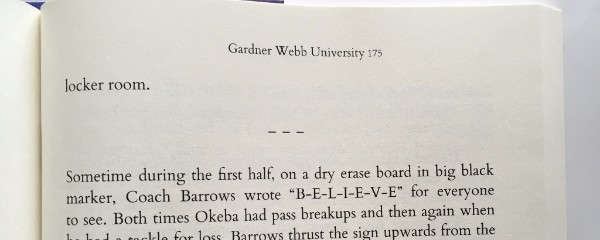Customer Service Shortcomings
I imagined my first printed book in a hardcover since the day I began writing it. Over two years of labor went into my first book and I wanted it to be perfect. Instead of settling on a paperback, which was much easier and cheaper to publish, I looked for a company that could print a hardcover with a dust jacket, like I always pictured.
Bookbaby.com was easy to use and their prices were fair. I found less expensive options, but quality was not comparable. Bookbaby employed a competent sales team who walked me through the process, answered all my questions, and guaranteed their work.
One order of a hundred hardcovers, comin’ up!
When the hardcovers arrived, the night before launch on December 2nd, I tore open the first box and began examining my first piece of treasure. Spine: check. Cover: check. Interior: no check… Something was wrong with the page numbers, they weren’t justified properly:
I reviewed my files and my upload looked good. I called Bookbaby to inform them of the mistake and find out what happened. Fortunately, they acknowledged their mishap and agreed to ship me a new set of books for free. Whew!
But, now that launch day was hours away, I didn’t have hardcovers to ship to my most loyal fans who paid more for a book than most people would dream of. Bookbaby said they would be able to get me revised copies in three weeks. I crossed my fingers for a pre-Christmas shipment.
Making (an attempt to make) Up For Their Mistake
Bookbaby agreed to replace the books the day I called them, on December 2nd, they just needed to work out the details. This is where the bulk of the problem arose. I read about authors having problems with their newly published books (through every publisher, not just Bookbaby), so I wasn’t terribly surprised to find the misprint. I was more surprised with the length of time required to resolve my issues.
From the time I called Bookbaby to the time they began production on the new books was eight (8) days. During that eight day span we exchanged multiple emails with large gaps of time in between each. After my initial email that included the images of the misprint, communication comprised of only minor details that could have been resolved on a 5 minute phone call.
I fumed for a full day before I could let the misprint go. It was Christmas-time and my book was already selling on Amazon. Being upset wasn’t going to speed up the process. So I waited. Finally, two days after Christmas, my revised books arrived.
I opened them and inspected the entire first box. No blemishes, no misaligned page numbers, everything looked great! I immediately began shipping orders out. Each box contained 20 books and one of the boxes had the word, “Bookmarks” on it. Curiosity lead me to open that box next.

To my astonishment, I received a packet of seven bookmarks. Each was themed around various genres (young adult, romance, mystery, etc.) and each cost about $0.02 to produce. I huffed and tossed my consolation prize aside. They already whiffed with their basic service, so why the “extra” effort?
How To Actually Improve Customer Service
This article from the Harvard Business Review is radically titled, “Stop Trying to Delight Your Customers.” After this experience, I have to agree. I can’t imagine anyone who saw my order for 100 hardcovers thought seven bookmarks would compensate for a shipment delayed by three weeks. Instead of taking an extra week to get the books to me, they could have cut that time down by simply calling me. That, more than bookmarks, would have made me much happier.
The article (great read for anyone in customer service) argues that customers don’t necessarily want to be delighted with unnecessary bookmarks, they’d much rather have timely and accurate service and quick solutions to their problems.
Two critical findings emerged that should affect every company’s customer service strategy. First, delighting customers doesn’t build loyalty; reducing their effort—the work they must do to get their problem solved—does. Second, acting deliberately on this insight can help improve customer service, reduce customer service costs, and decrease customer churn.
Next time, instead of wasting time and effort trying to delight your customers, find a way to resolve their problems faster. This, as stated in the article above, is a much more effective way to build brand loyalty.
# # #
What ways have you motioned to improve your customer service? Was it aimed at “delighting” customers or was it aimed at eliminating problems quicker?

